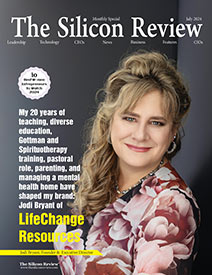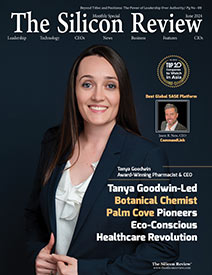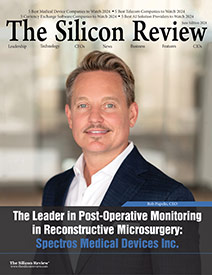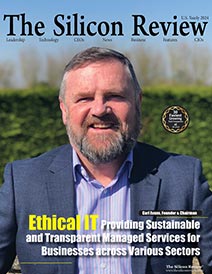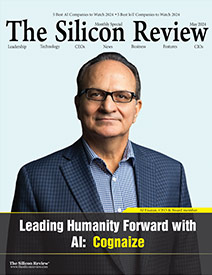30 Innovative Brands of the Year 2021
An Interview with Viren Joshi, Sigma Electric Manufacturing Corporation CEO: ‘Our Vision is to Make Sigma a Competitive Global Enterprise, Focused on Delivering Excellent Service to Diverse Customers Worldwide’
The Silicon Review
![]()
There are significant global opportunities for industrial precision-machined castings and precision metal components. The global economic situation is driving demand for cost-competitive suppliers with a strong supply chain process, across all industries. Sigma’s performance over 30 years as a supplier of choice, a trusted partner to leading MNC customers worldwide along with a proven reliable supply chain and global warehouse and tech center in the US, are added factors that support the company’s drive for successful business growth in global markets.
Sigma Electric Manufacturing Corporation manufactures electrical fittings and precision-engineered solutions. It offers ferrous and non-ferrous sand-casts, gravity and die-cast metal parts, and assemblies to electrical, utility, appliance, telecom, and industrial manufacturing industries.
Sigma was incorporated in 1982 and is headquartered in Pune, India.
Viren Joshi, Sigma CEO, spoke exclusively to The Silicon Review. Below is an excerpt.
Q. Explain your services in brief.
Sigma manufactures castings, precision components, and stampings for supply to varied market segments like electrical, appliances, diversified industrials, power tools, instrumentation, aerospace, defence, renewable energy, electric vehicles. The company has a worldwide sales, distribution, and service network to provide customers with solutions to meet their requirements.
Q. All businesses need systems in place to help them succeed each day and thrive long-term. How do you interpret this?
Sigma implements Standard Operating Procedures (SOPs) across its facilities — manufacturing, warehouses, and offices, helping achieve the best combination of people and machines by utilizing optimum labor, space, inventory, and equipment. This focused-disciplined approach helps in identifying and eliminating variation in work/processes. Also, this has acted as a benchmark to sustain the improvements achieved from past lean events and has provided a baseline for future continuous improvement programs.
Q. Unanticipated costs, the potential for setbacks, integration difficulties, and quality suffers are an inevitable part of SCM. How do you overcome these without disrupting the business flow?
Jidoka / Mistake Proofing: Jidoka is automation with a human touch, as Toyota would say. Sigma implements Jidoka in all its manufacturing cells and offices. It helps in identifying an abnormal condition within the process and triggers an immediate response for the same. The goal is to prevent a defective product from being passed to the next operation.
Benefits: Rejection Improvement – Improved quality by up to 30%.
Equipment Autonomation: Implementation of various autonomation initiatives has helped in reducing fatigue and errors. All Sigma cells are designed with a concept of autonomation i.e. separate man, separate machine. This has reduced fatigue and has minimized errors due to repetitive work. The goal here is multi-process handling, increased labor productivity.
Total Productive Maintenance or TPM: TPM implementation across all Sigma foundries has brought significant improvements in productivity, quality, cost reductions, set-up improvements, and machine life (up-time), on-time deliveries, and safe working environment and enhancing the morale of the employees.
Keeping in mind the theme, ‘Health is Wealth’ and ‘I Operate, I Maintain’, Sigma initiated a mammoth task of Jishu Hozen Pillar (autonomous maintenance) Deployment on over 1000 machine tools and equipment. Today, over 65 percent of the machines are covered under JH and the target is to cover 100 percent by 2021. TPM in Sigma revolves around eight pillars of traditional TPM i.e. Jishu- Hozen, Kobetsu Kaizen, Quality Maintenance, Plant Maintenance, Education and Training, Development Management, Office TPM, and Employee Health and Safety.
Plant leadership leads the Pillar deployment with a time-bounded master plan for implementation followed by frequent reviews to monitor the progress.
Benefits of TPM: Sigma’s machine availability has improved from 98.5 percent to 99 percent. Machine health and aesthetics has improved and now the machines are visual and healthy. Over 1000 Visual Standards are implemented on machines resulting in substantially reduced breakdowns, reduced maintenance repair expenses, and the plants are better positioned to meet all production requirements.
Q. How do you meet consumer demands and minimize overall costs involved in the production?
To be a highly productive and cost-competitive producer, Sigma practices ‘Just in Time’ — meet what the customer needs, in the quantity that the customer wants, and when the customer wants it — all the while using minimum raw material, equipment, space, and labor. To operate in ‘Just in Time’, Sigma follows three principles -- TOP:
T – Pace to Takt Time: All foundry machines work with a concept of takt time, where production is matched with the customer’s demand. A line balancing concept is introduced to make the processes lean and productive.
Benefits: On-time delivery improvement -- service levels improved from 80 to over 97 percent; achieved over 99 percent in the retail sector.
O – One Piece Flow: To reduce the lead time, the batch size of material flow is reduced. Sigma eliminated material handling by breaking the wall between die-casting and machining cells, reducing the transportation of material and excess motion by 100 percent. A concept deployed across all its facilities.
P – Pull System: Sigma operates with a weekly pull customer model. A weekly plan is converted into a daily plan by assembly lines and pull is created. Here, the material is pulled through the system only when needed, and this forces co-operation within the cross functions, departments, and prevents over and under production.
Benefits: Inventory reduction from 150 to 107 days.
Q. Tell us in brief about the manufacturing of metal castings and injection molded products and accessories.
At Sigma, the mold cavity is created using two hardened tool steel halves which have been machined into shape.
Hot chamber machine die-casting: Here, the injection mechanism is immersed in molten metal in a furnace attached to the machine for producing a component. Sigma has over 35 machines with capacities ranging from 12 to 250 tons and capable of producing parts ranging from 0.04 Kg to 2.50 Kg subject to projected area limitations.
Cold chamber machine
die-casting: In this process more molten metal is poured into the chamber than is needed to fill the die cavity, sustaining sufficient pressure to pack the cavity solidly with casting alloy. Injection pressures range from 3,000 to over 10,000 psi for both aluminium and magnesium alloys, and from 6,000 to over 15,000 psi for copper-based alloys. With over 45 cold chamber machines and capacities ranging from 150 tons to 900 tons, Sigma is capable of producing parts ranging from 0.03 Kg to 8.8 Kg, subject to projected area limitations.
Gravity die-casting: Also referred to as permanent mold, it is a repeatable casting process used for non-ferrous alloy parts, typically, aluminium, zinc, and copper-base alloys. Here, the molds used in casting are pre-heated up to 200°C before the molten metal is poured into the cast cavity. Proper thermal balance is maintained throughout the casting process and is done in various ways including external cooling techniques using water or relevant radiation techniques. Aluminium-bronze parts are manufactured for high and medium voltage fuse cut-outs through permanent mold gravity die-casting process.
Green sand-casting: The process involves the use of a melting furnace, liquid metal, pattern, and sand mold where molten metal is poured under gravity into sand molds. The patterns are designed and made in the in-house tool room.
Capable to produce sand castings out of copper, zinc, aluminium alloys, and cast iron, Sigma has “Sinto” make automated high-pressure molding lines. The high-pressure molding lines are capable of producing 120-180 molds/hr. and casting parts up to 20 kg.
Sigma is equipped with induction furnaces, CNC and VMC machines, heat treatment capacity, plating, and powder coating facilities.
Sigma also has the capabilities to manufacture machined investment castings to high precision, including to Aerospace AS specifications and to Military/Defence ITAR specs. Sigma produces high precision stampings, thin gauge (0.001”), and tight tolerances (0.0001”), where quality, reliability, and consistency are paramount.
Q. What are your trajectories for the next five years?
Sigma remains focused on profitable growth – higher revenues and EBITDA, and plans to grow organically, expanding the present product range and market segments. It also plans to keep growing inorganically through acquisitions with a focus on new products, processes, customers, and geographies. The vision is to make Sigma a competitive global enterprise, focused on delivering excellent service to diverse customers worldwide. Sigma remains focused on profitable growth. A new iron foundry at Jaipur and a new aluminium die-casting foundry at Pune have been set up recently. After the recent acquisitions of Microcast – Mexico, Avalon Precision Casting – CL, Ohio, and Tooling Dynamics – York, PA, the company is looking to make further acquisitions across the globe.
About the CEO/Founder in brief.
Viren Joshi has over 35 years’ experience in leading large engineering MNCs in India and globally. He has led Sigma Electric successfully for the past 8 years, creating a global leader in precision castings and components for the industrial markets. He set up Parker Hannifin operations in India and South Asia, and over 15 years led it to a leadership position in the fluid power market. He has wide experience in growing new businesses from start-up and managing rapid growth and performance at large engineering MNCs with a rich experience in M&A and is a keen practitioner of lean enterprise, profitable growth strategy, policy deployment, balance score card and talent development.
He has received a National Award from The President of India, for a paper on ‘Alternative Sources of Energy’. He has attended global programs on Leadership, Change Management, Balanced Score-card, Talent Development, and Mergers & Acquisitions. He was Chairman of CII, Pune Zone, is a member of CII, National Committees and actively participates in CII and Industry association activities. He speaks regularly at global and national conferences on a variety of topics. He is working with the Govt. of India and international associations to promote Global Supply Chain, Lean India and programs to create a vibrant US - India Supply Chain corridor. He has a Mechanical Engineering degree (Bombay University) and Post Graduate qualification in Management (Bombay University).




